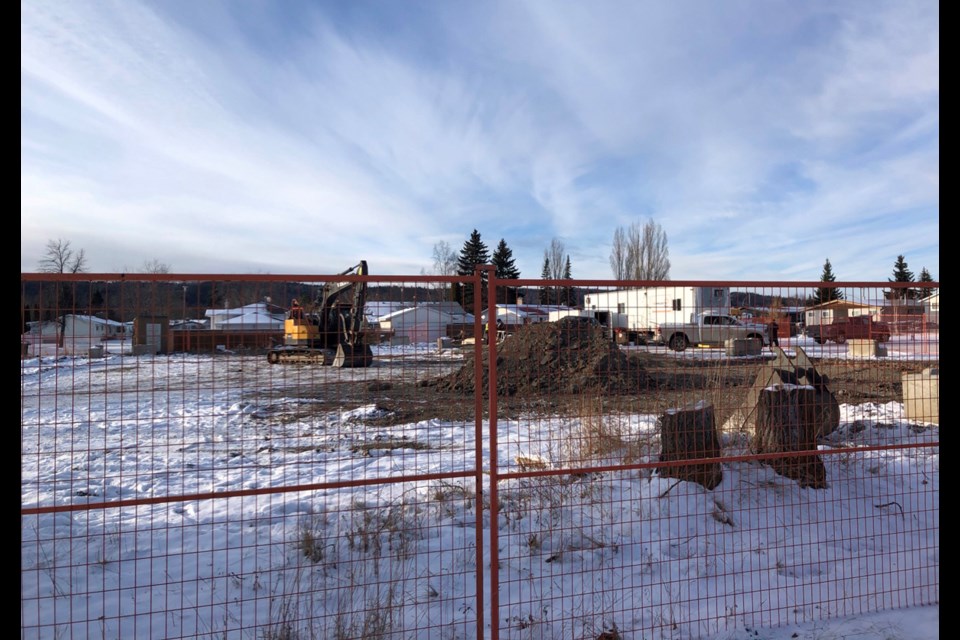When Vedder Crescent resident Darcy Colbert heard chainsaws start up near his home on Dec. 2, he wasn’t concerned.
In a letter from BC Housing, dated Nov. 21, he and fellow area residents had been assured that only three trees would be removed along the alley separating homes on Vedder Crescent from the Harmony House housing development under construction at 614 Zelkwas Ave. But when he came home later that day, he was surprised and upset to see all the trees along the alley cut down.
“I came back, and they fell every tree on the project. All you can see are stumps,” Colbert said. “All the trees are fallen down… I’m a little bit upset. It’s just dispiriting.”
The tall, mature aspens provided bird habitat, privacy and shade for the residents, he said.
When city council considered a rezoning to facilitate the development in February, 2021, the city received a 63-signature petition and letters from area residents against the project. However, Colbert said he's not against the project, he just wanted to see the trees remain standing.
“I’m all for anything housing right now,” Colbert added. “(But) we were told we would have some fibre still standing… for privacy and stuff. It’s too bad, because Harmony House could have looked nice with those mature trees.”
Once complete, the two-story, 14-unit housing project will be operated by the Phoenix Transition Society and offer transition house beds and second-stage housing (which provides short-term housing with on-site supports), mainly for Indigenous women and children including trans women, non-binary and Two-Spirit people, who need a safe place to stay.
In the Nov. 21 letter, BC Housing informed residents that design team had “worked with a Professional Forester to seek recommendations and we are pleased that most of the trees on the site can remain.”
“Three trees along the alley will be removed due to poor tree health. There may be a need to remove some trees along Union Street to accommodate required civil work, but we will continue to make every effort to retain as many trees as possible,” the BC Housing letter said.
Colbert said he wants to know what happened between Nov. 21, when the letter was sent, and Dec. 2 that justified removing the trees.
As a B.C. certified tree faller and dangerous tree assessor, Colbert said he doesn’t see any reason the trees needed to be removed.
“I’m a dangerous tree assessor and those trees were bulletproof. We just a had a wind event, and all those trees were still there,” Colbert said. “They definitely could have worked around those trees.”
He doesn’t blame the crew that removed the trees, he added, because the trees should have been properly ribboned to show which ones to remove and which to retain.
MORE TREES MAY HAVE TO COME DOWN
In an email, a spokesperson for BC Housing said that they “were not able to retain as many trees as we had originally hoped.”
“There were many factors involved in the decision, including compromised root structure due to civil work accessing the underground storm, water, sewer and hydro infrastructure. Due to the extent of excavation required for underground infrastructure, the root structures of trees would be compromised and it would be unsafe to leave the trees,” the spokesperson said in an email. “We are aiming to retain trees along Union Street, however, (BC Hydro) may require that additional trees are removed at a future date.”
As of Friday, several trees had been removed along Union Street but the majority remained in place.
The property will be fully landscaped and will include trees in the landscaping plan, the BC Housing spokesperson said in the email.
“The operator and BC Housing are committed to creating a beautiful site that includes landscaping that will enhance the site for residents and the neighbourhood,” the spokesperson said in the email. “Careful thought has gone into landscape planning, including planting native species that support biodiversity and pollinators. Many plants that have been incorporated into the landscape plan have medicinal and cultural values for Indigenous people in the region.”



